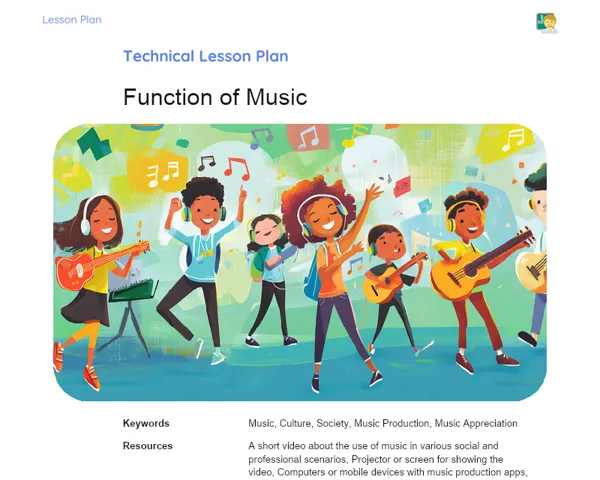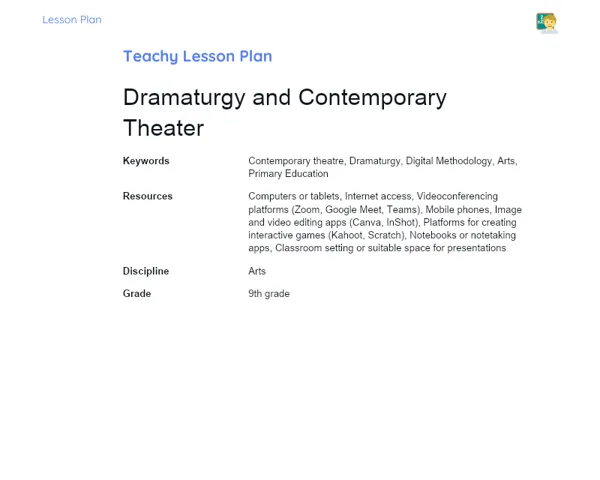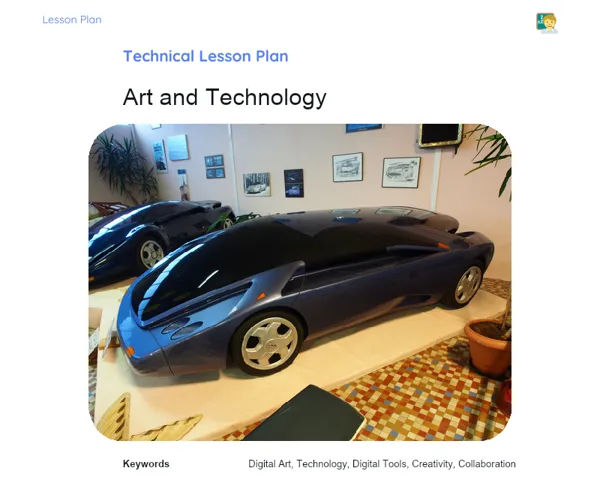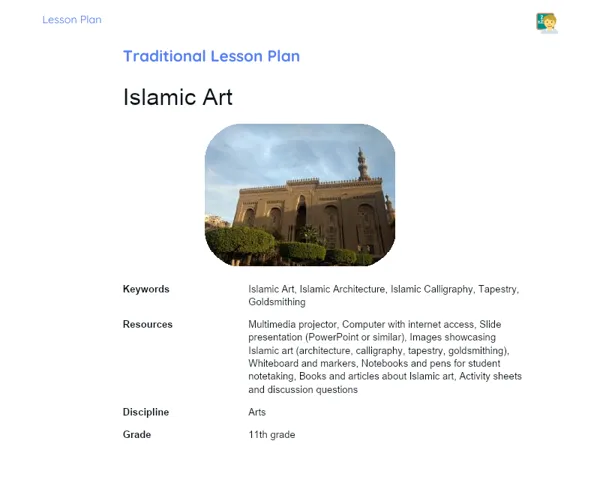Lesson Plan | Active Methodology | Music Circulation
| Keywords | Musical Circulation, Social Integration, Cultural Diversity, Interactive Activities, Music and Identity, Teamwork, Intercultural Negotiation, Mutual Respect, Practical Application, Theory and Practice |
| Necessary Materials | Computer with internet access, Projector and screen, Speakers, Paper and pens, Songs from various cultures (in digital media or online access), Suitable space for group activities |
Premises: This Active Lesson Plan assumes: a 100-minute class duration, prior student study both with the Book and the beginning of Project development, and that only one activity (among the three suggested) will be chosen to be carried out during the class, as each activity is designed to take up a large part of the available time.
Objective
Duration: (5 - 7 minutes)
The Objectives stage is vital for guiding both learners and the teacher towards the heart of the lesson. This section clearly outlines the main objectives, ensuring a mutual understanding of the lesson's expectations. Such clarity helps direct practical activities and assessments, ensuring that efforts align with the established learning outcomes.
Objective Utama:
1. Help learners appreciate how music cultivates social groups and fosters connection.
2. Enhance critical thinking skills by analysing how various music genres shape the dynamics within social settings.
3. Encourage practical application of previously covered theoretical concepts through engaging classroom activities that replicate real-life musical and social interactions.
Objective Tambahan:
- Encourage active participation in discussing real-world examples and cases of music in different social environments.
- Spark learners' curiosity about the cultural and anthropological dimensions of music.
Introduction
Duration: (15 - 20 minutes)
The Introduction aims to spark learner interest from the outset, linking their existing knowledge to the lesson’s theme. The proposed situational questions promote thoughtful reflection and critical thinking, setting students up for the practical application of the content. The contextualization broadens learners' perspectives on music's significance in society, urging them to recognize its relevance in academic or everyday contexts.
Problem-Based Situation
1. Imagine you’re an event planner for a group of teenagers from diverse cultures meeting for the first time. How would you decide on the music for the event to create a vibe of unity and respect?
2. Think about a scenario where musicians from various genres are set to perform at a single event. How can the song choices and the interaction among musicians shape group dynamics during the party?
Contextualization
Music isn't merely for entertainment; it plays a pivotal role in shaping and sustaining cultural and social identities. For instance, at music festivals around the globe, people from various backgrounds come together to embrace musical diversity, weaving a tapestry of cultural connections. Moreover, research shows that songs with similar beats can encourage individuals to act more cooperatively and supportively. This insight helps us appreciate music as a dynamic tool for integration and expression.
Development
Duration: (75 - 85 minutes)
The Development phase is crafted to allow learners to practically and interactively apply theoretical insights regarding musical circulation and its social impact. The suggested activities simulate real multicultural interactions through music, fostering creativity, integration, and mutual respect. This process reinforces learning while honing teamwork, negotiation, and cultural appreciation skills.
Activity Suggestions
It is recommended that only one of the suggested activities be carried out
Activity 1 - Cultural Festival: Harmonizing Differences
> Duration: (60 - 70 minutes)
- Objective: Cultivate skills in music selection and intercultural negotiation, encouraging integration and mutual respect among differing cultures.
- Description: In this task, learners will form groups of up to 5, each representing a different culture. They will receive a scenario for a fictional cultural festival and must select songs that embody their culture and can interweave with others, fostering integration.
- Instructions:
-
Split the class into groups of up to 5 learners, each representing a unique culture.
-
Present each group with a scenario of a cultural festival that includes other cultural groups.
-
Each group must choose and justify up to 3 traditional songs from their culture that would suit the event.
-
Groups then negotiate with one another to craft a final playlist that celebrates cultural harmony.
-
Each group presents their final playlist and explains their choices.
Activity 2 - DJ for a Day: Mixing Cultures
> Duration: (60 - 70 minutes)
- Objective: Empower students to grasp and implement the principles of musical blending and multicultural song selection, fostering diversity and cultural inclusion.
- Description: Students, organised in groups, will step into the role of DJs to create playlists for a multicultural event. They’ll research and select songs from different cultures, focusing on how to blend these tracks to create an inclusive and vibrant atmosphere.
- Instructions:
-
Assemble the students into groups of up to 5 and explain they will create a playlist for a multicultural bash.
-
Each group must scout for and select songs from at least 3 different cultures.
-
Groups should ensure smooth transitions between the songs, considering how to mix tracks while preserving the event’s energy.
-
Post-selection, each group presents their playlist and justifies their choices.
Activity 3 - Musical Circle: Sound Connections
> Duration: (60 - 70 minutes)
- Objective: Enhance understanding and appreciation of the diverse cultures represented in the classroom, cultivating a respectful and integrated environment through music.
- Description: This activity invites students to participate in a circle where they each share a significant song from their culture, aiming to forge a musical circle that bridges different traditions and encourages intercultural dialogue.
- Instructions:
-
Form a circle with all learners, asking each one to share a song that represents their culture or resonates strongly with their identity.
-
After each sharing, allow others to comment on the song, sharing their insights and connections.
-
Encourage learners to find common threads among the songs presented, fostering intercultural dialogue.
-
Wrap up with a group discussion reflecting on connections made and the role of music in building community.
Feedback
Duration: (10 - 15 minutes)
This feedback stage aims to solidify learning, allowing students to reflect on their experiences while discussing insights within a broader context. Such dialogue reinforces concepts of integration and mutual respect through musical circulation and facilitates a collaborative evaluation of the activities, identifying strengths and areas for enhancement in future applications of their knowledge.
Group Discussion
Initiate the group discussion by encouraging each team to share highlights of their main takeaways from the activities. Prompt them to explore how song selections influenced interactions between the different cultures represented and what insights they gained regarding music’s role in forming social groups. Suggest they reflect on which songs stood out as most effective in promoting integration and why.
Key Questions
1. How did your song choices influence the interaction between cultural groups during the activities?
2. Did you encounter any surprises or challenges while trying to blend songs from various cultures into a cohesive playlist?
3. What lessons can you draw from today’s class for real-life multicultural interactions?
Conclusion
Duration: (5 - 10 minutes)
The conclusion aims to cement learning, ensuring learners come away with a coherent understanding of the material covered. Additionally, this section reinforces the connection between theory and practice, emphasising the applicability of these concepts in students’ daily lives. Ultimately, it reiterates the importance of the topic, motivating learners to continue exploring and valuing music as a means of integration and cultural expression.
Summary
To wrap things up, it’s crucial to summarise the key points about musical circulation and its impact on social group formation. Throughout the lesson, learners delved into how music acts as a powerful agent for unifying diverse cultures and examined practical examples that illustrated these concepts in both real and imagined scenarios.
Theory Connection
Today's lesson was structured to connect theoretical insights about musical circulation to practical applications through interactive activities. Students experienced first-hand how the selection and fusion of songs can influence group dynamics and cultural expression, reinforcing learned theories and highlighting their relevance in everyday life.
Closing
The significance of musical circulation extends far beyond mere entertainment; it’s vital in shaping identities and nurturing healthy social exchanges. Grasping these processes is essential for learners, equipping them with the tools to appreciate and utilise music in various aspects of their lives—be it leisure, education, or future careers.



